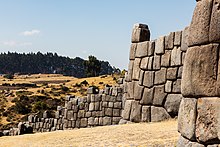Sacsayhuamán
The ruins of the Inca fortress Sacsayhuamán ( Hispanic spelling of the original Quechua name Saqsaywaman or Saksaywaman emphasized on the penultimate syllable ) is today one of the most important sights from the Inca period and is located on the outskirts of the Peruvian city of Cuzco . It is about 3 km above the city center. The complex was to serve as a place of representation and as a military fortification protect the most endangered access to the city. Structural forms that most likely point to sanctuaries , such as niche spaces, circular arenas around 100 m in diameter and stairs built in individual boulders, speak against an interpretation as a defensive structure . During the Spanish conquest , the complex was partially destroyed, and the building structure has been further damaged by earthquakes since then.
The Inca Pachacútec Yupanqui and Túpac Yupanqui are considered to be the builders of the site . According to Pedro Cieza de León, 20,000 people are said to have worked on it during the 70-year construction period in the second half of the 15th century .
Surname
The name Saksaywaman means in Quechua ( Qusqu-Qullaw ) "satiated falcon", whereby saksay means " satiate " and waman means "falcon". The Academia Mayor de la Lengua Quechua (AMLQ) interprets the name as Saqsaywaman , "tense falcon" ( saqsa , "tense, curled up") or "falcon with a curled head" Saqsaywaman is a very common Quechua spelling, also in Quechua -Readers of the Cusco region . The verb saksay is in Cusco Quechua often saqsay written because k and q in this Quechua variant on the end of a syllable by Frikativierung as, in many areas but speaking the same [x] and [χ] and so Saqsaywaman despite these letters as " satiated falcon "or" Sate yourself, falcon! " (Saksay / Saqsay, Waman!) is translated.
In 1608, Diego González Holguín mentions Çacça (y) huaman (synonym anca ) as meaning “big eagle (golden eagle)”, which is also the name of the Inca fortress in Cusco. He denied the meaning “satiated hawk”, which was generally assigned to the name at that time.
Saksaywaman has also been interpreted as a puma head, as this site, seen from the air, has the shape of a puma head, with the streets of old Cusco forming its body. Because of this, a name explanation Saqsauma “marbled head” from saqsa (“marbled”) and uma (“head”) has been constructed.
construction
The most important "line of defense" consists of three cyclopean , terraced zigzag walls . They are 600 m long. The lower wall is 9 m high, the middle 10 m and the upper 5 m high. To build the wall, huge stones were transported from the quarries 20 km away and then worked on until they fit together seamlessly. The largest stone is 9 m high, 5 m wide, 4 m thick and weighs over 200 tons.
Above you can see the remains of two square towers and a round tower, the Muya Marca. They are connected by underground passages. The terraces are crossed by canals for water supply and for draining rainwater. Behind the ramparts is a large square where the Sun Festival ( Inti Raymi ) is celebrated every year on June 24th, which the President also attends.
In the rear part of the complex there is a circular square, laid out deepened and supported by a man-high wall ring. Next to it there is a short, narrow tunnel that can only be passed by a single person, as well as various remains of walls and a natural "slide" in the rock.
Web links
Individual evidence
- ↑ a b c Qosqo, capital sagrada de los Inkas: Saqsaywaman
- ↑ Teofilo Laime Ajacopa, Diccionario Bilingüe Iskay simipi yuyayk'ancha, La Paz, 2007: saksay . intr. Hartarse, saciarse. || Hartar. tr. Saciar. Saksachiy. || Empalagar, hastiar. Amiy.
- ↑ Diccionario Quechua - Español - Quechua, Academía Mayor de la Lengua Quechua, Gobierno Regional Cusco, Cusco 2005: saksay . v. Saciarse, hartarse, satisfacerse, llenarse .
- ↑ Teofilo Laime Ajacopa, Diccionario Bilingüe Iskay simipi yuyayk'ancha, La Paz, 2007: waman . s. Halcón. Ave rapaz diurna.
- ↑ Diccionario Quechua - Español - Quechua, Academía Mayor de la Lengua Quechua, Gobierno Regional Cusco, Cusco 2005: waman. - s. Zool. (Buteo poecilochros Gurney) Aguilucho cordillerano. Order of falconiformes. Familia accipitridae. Ave de color gris– plomo, con áreas ferruginosas, blancas, negras y cafés. SENSE: wamancha.
- ↑ a b Diccionario Quechua - Español - Quechua, Academía Mayor de la Lengua Quechua, Gobierno Regional Cusco, Cusco 2005: Saqsaywaman . s. Arqueol. (etim. saqsa uma, cabeza crispada; waman, halcón: cabeza crispada de halcón) .
- ↑ Cristóbal Estombelo Taco: Inka Taytanchiskunaq Kawsayninta Yacharispa . ( Memento of June 6, 2014 in the Internet Archive ) (PDF) Instituto Superior Público La Salle, Proyecto CRAM II, Urubamba, Cusco 2002. S. 8f. (Online: Portal de Educación del Perú).
- ↑ Teodosio Chavez Campos, Israel Chavez Sumarriva, Nadia Chavez Sumarriva: Tradición andina: edad de oro . 2a ed. Universidad Mayor de San Marcos, Lima 2007. p. 31.
- ^ Revista Saqsaywaman, Edition 1, pp. 89f. Patronato Departamental de Arqueología del Cuzco, 1970. SACCSAY HUAMAN! (Saciate halcón)
- ↑ Diego Gonçález Holguín: Vocabulario de la Lengva General de todo el Perv llamada Lengva Qquichua o del Inca . ( Memento of April 16, 2014 in the Internet Archive ) (PDF) Imprenta de Francisco del Canto, Lima 1608. P. 26f .: La fortaleza del Inca en el Cuzco era Çaçça huaman y Çaççay huaman significa "Águila real la mayor" y no halcón satisfecho como se ha interpretado generalmente. P. 75: Çacça huaman pucara. From castillo del Inga en el Cuzco. Çacçay huaman, o anca. Aguila real la mayor.
Coordinates: 13 ° 30 ′ 28 ″ S , 71 ° 58 ′ 56 ″ W.





